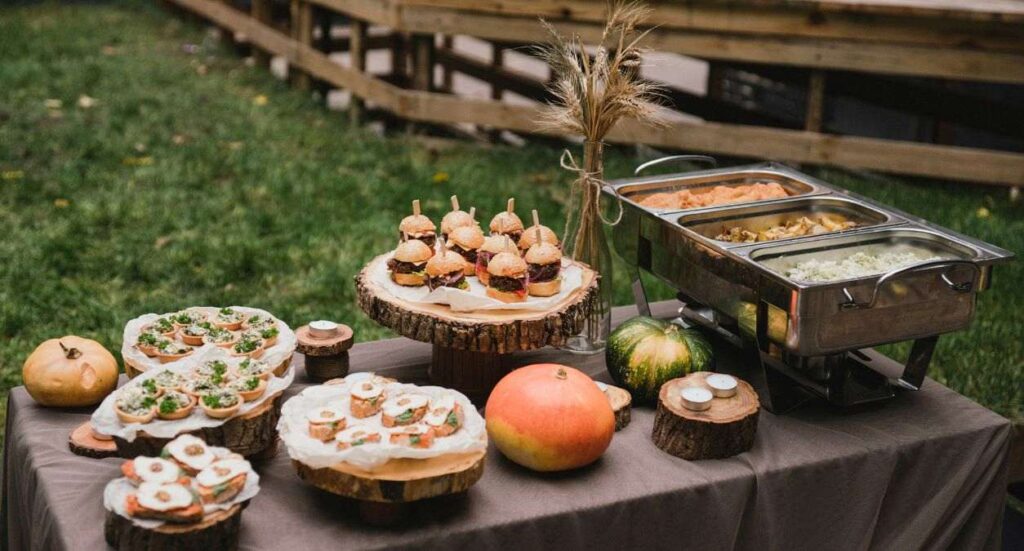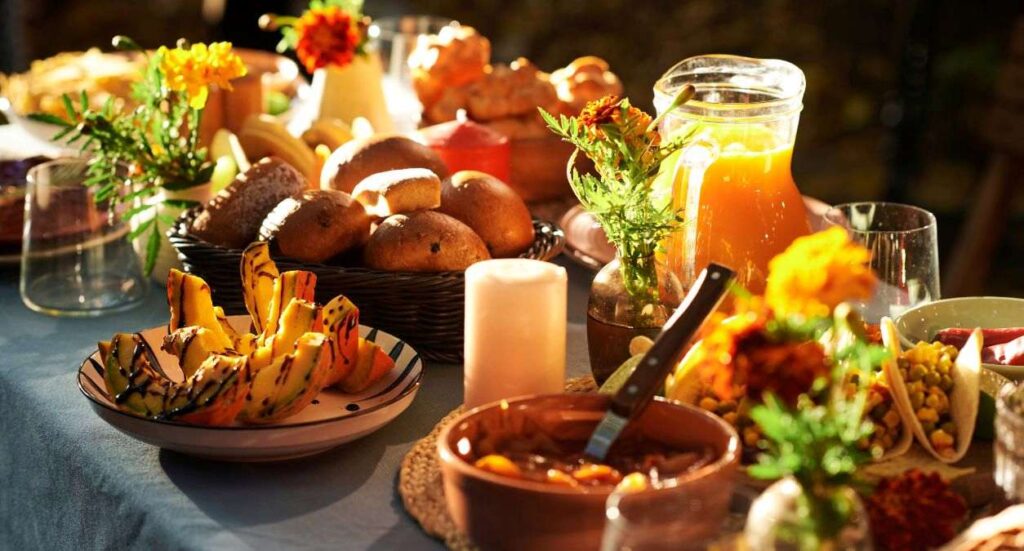Table of contents
Table of contents
If you love food and enjoy bringing people together, starting a catering business can be incredibly rewarding. Autumn is one of the best seasons to dive in – the weather is cooler, the festive season is around the corner, and people are looking for cozy, comforting meals.
From rustic autumn weddings and office parties to Halloween and Christmas celebrations, there’s no shortage of events that need tasty, well-presented food. Whether you dream of running a full-service catering company, a mobile food truck, or a dessert-focused pop-up, this is the perfect time to turn that passion into a profitable business.
In this guide, we’ll take you through the most promising types of catering businesses to start in autumn, how to get started, and which opportunities are in high demand. By the end, you’ll have a clear roadmap for launching a catering business that’s both seasonal and in demand.
Why autumn is the perfect time to start a catering business

Autumn brings a shift in both food and lifestyle. People naturally gravitate toward hearty meals, warming drinks, and seasonal flavours. For caterers, this is a golden opportunity: menus can feature roasted vegetables, squash, pumpkin-based dishes, spiced desserts, and comforting mains that appeal to a wide audience.
The calendar also fills up with events that require catering services: Halloween and fireworks night, corporate functions, festivals, cultural celebrations, and community gatherings. This combination of seasonal ingredients and event demand makes autumn an ideal season for anyone considering starting a catering business.
Beyond the demand, autumn also allows you to test your business model before the high-pressure winter season begins. It gives you time to refine menus, establish relationships with suppliers, and develop a marketing strategy that works.
Types of catering businesses to start in autumn
When it comes to catering, there’s no one-size-fits-all approach. Here are some of the most promising options for autumn:
Corporate catering
Corporate clients are always in need of reliable caterers. Autumn is a busy season for offices, with conferences, team-building retreats, and holiday parties. Offering buffet lunches, canapé platters, or themed festive menus can attract repeat business. Corporate catering is often one of the higher-paid niches because businesses tend to budget generously for hospitality.
Mobile catering and food trucks
For those who want flexibility, mobile catering is a great option. Farmers’ markets, autumn fairs, and sporting events continue even as temperatures drop. A food truck or pop-up stand serving hot drinks, soups, and seasonal snacks can be highly profitable.
Autumn menus for mobile catering work especially well with comfort foods like spiced cider, hot chocolate, toasted sandwiches, pies, and soups. A mobile setup allows you to experiment with locations, menus, and pricing without committing to a large kitchen.
Holiday party catering
Autumn marks the beginning of the festive season, which can be a lucrative window for caterers. Halloween, Bonfire Night, and Christmas parties all require catering. Families and organisations alike are willing to pay for food that makes their celebrations special.
Holiday party catering can include themed spreads, canapés, full holiday dinners, or interactive food stations. While seasonal, this niche often commands premium rates.
Event catering
Full-service event catering involves providing complete meals and drinks for weddings, parties, and community functions. Autumn weddings are especially popular, with couples favouring the season’s colours, cosy atmosphere, and seasonal produce.
Menus might include roasted root vegetables, hearty soups, baked goods, and warm desserts. Presentation is key – rustic décor, seasonal flowers, and creative plating can help your service stand out.
Specialised catering (dietary needs)
Health-conscious clients and those with dietary restrictions create strong demand for specialised catering. Vegan, vegetarian, gluten-free, halal, and allergen-friendly menus are increasingly sought after. Autumn produce such as squash, mushrooms, nuts, and apples lends itself perfectly to creative dishes for these audiences.
Caterers who specialise in dietary needs can often charge higher rates, as this niche is underserved. Retreats, wellness events, and certain schools or organisations are ideal markets.
Dessert and beverage catering
A dessert- or beverage-focused catering business can be a low-overhead, high-appeal option. Think hot chocolate bars, coffee carts, dessert tables, or mulled wine stands at winter markets. Autumn flavours like caramel, cinnamon, apple, and pumpkin can make your offering particularly attractive.
How to start a catering business in autumn

Launching a catering business might seem daunting, but breaking it down into steps makes it manageable. Here’s a practical framework:
- Research local demand – Identify upcoming events, understand what competitors are offering, and find gaps in the market.
- Define your niche – Choose whether to focus on weddings, corporate contracts, mobile catering, or holiday parties. A clear niche helps you target marketing and build a reputation.
- Create a seasonal menu – Include autumn-inspired dishes like pumpkin soup, spiced apple desserts, roasted vegetables, and hot drinks.
- Obtain necessary licences and certifications – This typically includes food hygiene certificates, alcohol licences if applicable, and local authority registration.
- Arrange catering insurance – Protects your business from claims related to accidents, foodborne illness, or equipment damage.
- Market your services – Build a social media presence, attend local events, network with planners, and offer tasting sessions to potential clients.
- Start small and scale – Begin with smaller private events to gain experience and testimonials, then gradually pursue larger contracts.
Marketing tips for autumn catering

Marketing is critical, especially when you’re launching in a competitive season, and autumn provides plenty of opportunities to showcase your offerings. Using seasonal visuals on social media is a great way to attract attention, think pumpkins, warm lighting, and rustic tablescapes that highlight your autumn menus. Partnering with local event planners, florists, and venues can help secure valuable referrals, while early-bird promotions for Halloween, Thanksgiving, and Christmas events can encourage clients to book in advance. Sharing behind-the-scenes content, such as food preparation or tasting events, engages followers and gives your audience a sense of your style and quality. Collecting testimonials and highlighting client reviews also builds trust quickly, which is essential for attracting repeat business. When done well, effective marketing can make the difference between a slow autumn and a fully booked calendar.
Equipment and operational advice
Autumn events often take place indoors, but mobile and outdoor setups are still common. Here are some operational tips:
- Insulated carriers and warming trays ensure food stays hot during transport.
- Portable heaters or tents may be needed for outdoor markets or festivals.
- Storage for seasonal ingredients is essential – pumpkins, squash, and root vegetables need cool, dry spaces.
- Staffing planning matters: peak autumn weeks around Halloween and Christmas may require extra hands.
- Consider investing in multi-purpose equipment to keep costs low while maintaining quality.
Proper equipment and planning improve efficiency and client satisfaction, which is critical for repeat business.
Seasonal trends to watch

Keeping up with trends helps your business stand out:
Flavours
While pumpkin spice remains a classic, experimenting with flavours like roasted chestnut, pear and ginger, smoked autumn meats, or caramelised apple dishes can help your menus stand out. Offering unique, seasonal tastes not only attracts clients but also showcases your creativity as a caterer.
Presentation
How you present your food is just as important as how it tastes. Grazing boards, interactive food stations, and themed dessert bars are increasingly popular, adding a “wow” factor to events and enhancing the overall guest experience.
Sustainability
Clients are becoming more conscious of environmental impact, and sustainability can be a strong selling point. Farm-to-table menus, minimal packaging, and initiatives to reduce food waste resonate with customers and can differentiate your catering business in a crowded market.
Health-conscious options
Offering seasonal vegan or gluten-free menus is no longer just a trend – it is a growing market segment. Providing health-conscious alternatives ensures that all guests can enjoy your food, and it can position your business as inclusive and modern.
Catering businesses that adapt to these trends while maintaining high quality can capture more bookings and justify premium pricing, making trend-awareness a crucial part of autumn planning.
Autumn catering startup checklist
Here’s a mini-planner to ensure you cover all essential steps:
- Licences & certification
- Insurance coverage
- Menu planning with seasonal produce
- Staffing & training for peak events
- Equipment & storage setup
- Marketing & promotions targeting autumn clients
- Pricing strategy and profitability calculation
Using this checklist helps you stay organised and ensures no important detail is overlooked.
Get Catering Insurance from Protectivity
*Disclaimer – This blog has been created as general information and should not be taken as advice. Make sure you have the correct level of insurance for your requirements and always review policy documentation. Information is factually accurate at the time of publishing but may have become out of date.
Last updated by

















